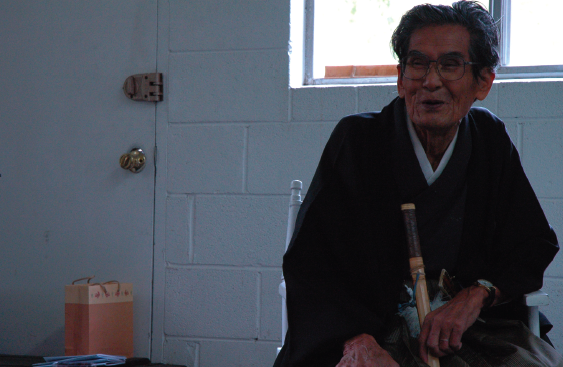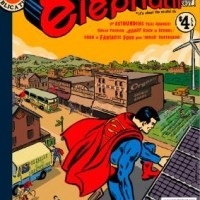
Yumis, or bows, past and present. Photo by Corey Kohn.
Walk on the Line of the Present via Scott Spanbauer, from the Spring 2006 issue.
On a beautiful May morning, Kanjuro Shibata, Sensei, 20th in a line of Zen archery masters, kneels at the front of his dojo, or practice hall, wearing a brown kimono and a crisp, skirt-like hakama. He is now 87 years old, but could pass for 65. His manner is formal, yet tender, like a grandfather. The regular Sunday morning class is closing, and Sensei (a title meaning teacher) bids his students farewell in the abbreviated English they learn along with the kyudo form. For years, he has traveled nearly year-round, leading seminars throughout the U.S., Canada and Europe. Tomorrow morning he leaves on another trip.
He offers a goodbye and thank you, then gets up and adds “dasvedanya,” a reminder of his years in a Soviet prison camp after World War II. He smiles, and walks out of the dojo’s sunlit entrance. The stark, white cinder-block structure is softened by the addition of gardens, wooden walkways, an entry foyer, and a decidedly Japanese looking outdoor kyudo range, called an azuchi. Today, a children’s class has practiced in the azuchi.
Besides the main dojo in Boulder, Sensei has subsidiary groups in Vermont, Halifax, Boston, Washington D.C., Philadelphia, New York, Berkeley, Amsterdam, Vienna and Marburg, to name a few. Along the way, Sensei has acquired 100’s of students, all of whom he regards as extended “family.”
There’s a cutting, earthy quality to his teaching style. Although outwardly a Zen master who teaches what he calls “stand-up meditation,” much of Sensei’s instruction focuses on how to live properly: placing the needs and welfare of others first. The Japanese word for this outlook is rei—literally, “correct behavior.”
Kanjuro Shibata XX. Sensei was born Yoshimune Shibata to an old samurai family in Kyoto, the ancient capital of Japan. Munekazu Shibata, first to carry the Kanjuro Shibata title, lived in the mid-1500’s on the island of Tanegashima off Kyushu. He and his forebears served the Shimazu clan as bowmakers and archers, carrying the title yumishinan; or bowmaster. In 1574, he moved to Kyoto, where subsequent generations continued to serve the military shogunates and nobility during the Tokugawa era (1600-1868). At some point, the Kanjuro Shibatas received the more honorific title onyumishi, meaning “master bowmaker and archer” from the Shogun, a title subsequently passed from generation to generation.
According to Sensei, the practice of discipline—kyudo; rei, and bushido, the way of the warrior and samurai code—was of the utmost importance in his family. Sensei is also quick to point out that this kind of discipline is not a big deal: “When eating,” he says, “you wait for everyone to arrive before starting. It’s natural.” Nevertheless, he finds that Westerners often lack that basic concern, noting that at American meals the operating logic is “help yourself.”
As a result, sitting down to dinner with Sensei often feels like an etiquette lesson: the guest, or Sensei, is always served first, and no one starts until everyone is served and the assembled group has bowed and said itadakemasu—I am ready to receive. “To make anything special of this is absurd,” he says. Asked if ignorance of such manners is an impediment to one’s path, Sensei hesitates, not wanting to slight Western students, but continues, “Rei is a direct teaching of Zen Buddhism. It’s very basic, so yes, it’s a problem if Western students don’t have that understanding.”
Shibata Sensei holds two people in the highest regard: the Vidyadhara, Chögyam Trungpa Rinpoche, who invited him to teach manners, and kyudo, to his American Buddhist students in 1980; and the 19th Kanjuro Shibata, Muneshige Shibata, his grandfather (Sensei’s father, who married into the Shibata family, did not inherit the Kanjuro Shibata title, but acted as his father-in-law’s secretary, running the family bow-making business). At the age of eight, Sensei began learning kyudo and bowmaking from his grandfather, who in addition to carrying the title onyumishi, was the official bowmaker to the Imperial family, a commission bestowed on the 18th Kanjuro Shibata by the Meiji Emperor in 1889. As the Imperial bowmaker, he was responsible for making the Goshinpo Yumi, a sacred bow used for the purification and consecration of the shrine at Ise, the main shrine of the Shinto religion, every 20 years.
Sensei’s relationship with his grandfather was a severe one. There was love between them, but in Sensei’s words, his grandfather was “completely harsh,” and was not averse to hitting or slapping when necessary. According to Sensei, the many lessons he received from his grandfather were never verbal—he simply manifested, commanding that Sensei “watch with the heart, not the eyes.” In this way, Sensei received “all of the jewels of his [grandfather’s] heart and mind.” At this time he also became familiar with Yamamoto Tsunetomo’s Hagakure, circa 1716, perhaps the most important piece of samurai literature. Consisting mostly of brief anecdotes and maxims, Hagakure, says Sensei, contains the supreme lessons: loyalty to one’s teacher, readiness for death and detachment from this life, compassion for others and an anti-intellectual bias that favors “first thought” action over deliberation.

The Imperial Bowmaker to the Emporer of Japan—in his main dojo in Boulder, Colo. Photo by Corey Kohn.
Even though these principles have survived in printed form, Sensei says people’s understanding of the samurai way is now watered down. “Now, even in Japan, it’s me first in everything.” He enumerates five important samurai principles: loyalty; behave properly with all, no matter who they are; a life of extravagance is fruitless—therefore do not develop it; develop trust between yourself and fellow warriors; and have courage—otherwise life is fruitless. Sensei adds that the pride of the bushi, or warrior, 450 years ago was seppuku (ritual suicide by disembowelment; and proof of one’s loyalty, bravery and selflessness). “In the present age,” he continues, “there are no samurai living, so it is impractical to cut one’s belly open.” Asked if he himself weren’t a samurai, Sensei insists, “To be reasonable is to have a modest heart when replying to such a question.”
At the age of 20, after attending military school and university, Sensei was drafted into the army and sent first to Korea, then Manchuria, where he served in a horse-drawn artillery unit. At the end of the war, his unit was captured by the Russians. In August, 1945, he was sent to a Central Asian prisoner-of-war camp near Samarkand, just north of Afghanistan. The trip across Russia in cattle cars took a month, and conditions at the camp were horrible. The men worked in a coal mine, ate cabbage soup and a small piece of black bread twice a day; the evening meal’s soup was fortified with a little camel liver. One in ten survived.
Finally, in the fall of 1948, he was released and returned to Japan. Two years later, he married in a wedding arranged by his grandfather, and the marriage produced two daughters: In 1959, Kanjuro Shibata Muneshige died, and Sensei assumed the title of Kanjuro Shibata XX., Onyumishi, with full responsibility for bow-making, kyudo teaching, and the making of the Goshinpo Yurni (which last took place in 1974). When his daughter Hiromi married her high-school sweetheart Nobuhiro, Sensei asked him to assume the Shibata namenand lineage, not an unusual event – the l8th Kanjuro Shibata had also married into the family. Sensei began training Nobuhiro in the arts of kyudo and bowmaking much as his grandfather had’ taught him.
Sensei was increasingly disturbed by changes in Japanese society – a turn toward materialism that was rapidly changing kyudo from a meditative art into a sport. Rather than practicing kyudo as a way of “cleaning the mind,” many students, especially those he taught at a local university, were intent on hitting the target. To this day, Sensei constantly exhorts his students to practice “mind kyudo, not sports kyudo,” and to give up hope and fear regarding hitting the target. The emphasis on winning prevalent in Japan led him to accept an invitation by Trungpa Rinpoche in 1980 to teach in the West.
It was an unusual step for someone of Sensei’s stature, and an unpopular one in Japan. Trungpa Rinpoche had been looking for genuine teachers of Japanese contemplative arts, and heard of Sensei through Kobun Chino Roshi, a Zen master living in the U.S. (at the behest of Sukuzi Roshi, author of Zen Mind, Beginner’s Mind and also a friend of Trungpa’s). The fresh outlook and non-competitiveness Sensei found in many of Trungpa’s students inspired him to return year after year for extended teaching stays. In 1985, Sensei moved to the U.S. permanently.

Mike Smith, a longtime Kyudo student & teacher—as well as owner of the landmark Trident Booksellers & Café—performs a ceremony at the Boulder dojo.
Now, after more than 20 years of teaching, the quality of Sensei’s instruction has deepened as his students’ understanding has matured. Moving emphasis away from shake, or form, he increasingly points out how students can mix mind with meditation, which he calls shashin. “It might be possible to enter kyudo through technique alone, but this is not what I believe,” he says. “If you shoot the arrow mu -shin-no heart – that is correct heart.’ This is Zen.”
Sensei is often asked what “mu” is. “That’s like asking ‘what is air? “‘ he says, “Mu is something scholars try to explain with words. It must be experienced through meditation.” At instructor trainings, Sensei will offer a detailed critique of each participant’s practice. Most are older students, and the comments, which range from politely revealing to devastating, go far beyond the usual corrections to form. During classes, Sensei often criticizes proficient archers for thinking too much and praises beginners who release the arrow with little expectation.
The result of practicing shake and shashin thoroughly, says Sensei, is shahin—dignity. “At the end, you are actually manifesting supreme dignity.” Kobun Chino Roshi, a Zen master and close friend of Sensei, once said: “As Shibata Sensei has stated, you do not achieve shahin. What is polished out naturally unfolds as characteristics of the archer’s own life itself. These characteristics are seen not only during shooting but in a person’s appearance and how one’s life is manifested from day-to-day.”
The larger question of how Sensei’s lineage will continue is only beginning to come into focus. Nobuhiro Shibata, who for many years has made all of the Shibata family bows, will carry the Kanjuro Shibata, onyumishi and imperial bowmaker lineages in the next generation, but has expressed little desire to be a kyudo master. Whether Sensei’s teachings will live on in the West remains to be seen: “It’s up to each individual to see if they can do that. They do understand [kyudo] intellectually, but whether they understand it in their hearts remains to be seen.”
As Kobun Chino Roshi said: “Sensei opens up to you, and there’s no stinginess in teaching you. His whole mind and body—his presence—is like an arrow arriving from ancient times.”
“Hope is not the point. The point is that through long and genuine practice, your natural dignity as a human being comes out.”
The above, by Scott Spanbauer, is updated and adapted from the original, published in Shambhala Sun magazine in 1992.
Our video interview with Sensei—be sure to check out his song offering at the end.







Read 8 comments and reply